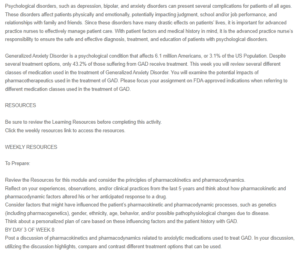Treatment Strategies for Generalized Anxiety Disorder in Patients with Chronic Illness
Peer Response 1
Hello Ivonne,
Thank you for your post. Your thorough analysis of the pharmacologic options for treating generalized anxiety disorder (GAD) in patients with chronic kidney disease (CKD) undergoing dialysis is insightful. Considering the patient’s age, renal function, and the medication’s pharmacokinetics is crucial. In your patient’s case, Lorazepam’s long half-life and potential interactions are notable concerns. I would suggest considering alternative medications with shorter half-lives and reduced renal excretion, such as selective serotonin reuptake inhibitors (SSRIs) like sertraline or escitalopram (Katzung et al., 2021). These SSRIs are generally well-tolerated and have a lower risk of sedation compared to benzodiazepines. Additionally, incorporating non-pharmacological approaches like cognitive-behavioral therapy (CBT) may enhance the overall management of GAD while minimizing the risks associated with medications (Nakao et al., 2021). Monitoring your patient closely for any adverse effects or changes in anxiety symptoms will be essential. Further, factors such as hepatic impairment, drug-drug interactions, and patient adherence may also influence treatment outcomes and should be considered in your patient’s comprehensive care plan.
References
Katzung, B. G., Kruidering-Hall, M., Tuan, R. L., Vanderah, T. W., & Trevor, A. J. (2021). Katzung & Trevor’s Pharmacology Examination and Board Review, Thirteenth Edition. McGraw Hill Professional.
Nakao, M., Shirotsuki, K., & Sugaya, N. (2021). Cognitive–behavioral therapy for management of mental health and stress-related disorders: Recent advances in techniques and technologies. BioPsychoSocial Medicine, 15(1). https://doi.org/10.1186/s13030-021-00219-w
Response 2
Hello Chelsee,
This is a very informative post. Your detailed analysis of Venlafaxine and Buspirone for GAD treatment is commendable. I concur with the importance of considering both pharmacokinetics and pharmacodynamics for individualized therapy. Additional factors to explore include co-morbidities; did any patients have conditions like liver or kidney disease impacting drug metabolism or excretion? Consideration of drug interactions is crucial, too, ensuring that concurrent medications do not interfere with the effectiveness or exacerbate side effects of Venlafaxine or Buspirone (Arcangelo et al., 2017).
Further, non-adherence could be a contributing factor; did patients face challenges adhering to the medication regimen, potentially impacting treatment response? Investigating reasons for non-adherence can guide tailored interventions. Genetic factors also play a role hence, exploring individual variations in drug metabolism and receptor sensitivity through pharmacogenetic testing may provide valuable insights.
Additionally, considering alternative treatment options is prudent. Other SSRIs/SNRIs like Escitalopram, Duloxetine, or Paroxetine could be explored if Venlafaxine proves ineffective or intolerable. Augmentation strategies, such as adding Buspirone to an SSRI/SNRI, might enhance response for patients with inadequate symptom control (Rosenthal & Burchum, 2021). Additionally, cognitive-behavioral therapy (CBT) stands as a potent, evidence-based alternative or complementary treatment for GAD, providing a holistic approach to patient care. It is important to note that GAD treatment is individualized and necessitates ongoing monitoring and adjustments. By delving into these factors and exploring alternative options, therapy can be optimized for each patient, ensuring their overall well-being.
References
Arcangelo, V. P., Peterson, A. M., Wilbur, V., & Reinhold, J. A. (Eds.). (2017). Pharmacotherapeutics for advanced practice: A practical approach (4th ed.). Ambler, PA: Lippincott Williams & Wilkins.
Rosenthal, L.D., & Burchum, J. R. (2021). Lehne’s pharmacotherapeutics for Advanced Practice Nurses (2nd ed.). St. Louis, MO: Elsevier.
ORDER A PLAGIARISM-FREE PAPER HERE
We’ll write everything from scratch
Question
Psychological disorders, such as depression, bipolar, and anxiety disorders can present several complications for patients of all ages. These disorders affect patients physically and emotionally, potentially impacting judgment, school and/or job performance, and relationships with family and friends. Since these disorders have many drastic effects on patients’ lives, it is important for advanced practice nurses to effectively manage patient care. With patient factors and medical history in mind, it is the advanced practice nurse’s responsibility to ensure the safe and effective diagnosis, treatment, and education of patients with psychological disorders.

Treatment Strategies for Generalized Anxiety Disorder in Patients with Chronic Illness
Generalized Anxiety Disorder is a psychological condition that affects 6.1 million Americans, or 3.1% of the US Population. Despite several treatment options, only 43.2% of those suffering from GAD receive treatment. This week you will review several different classes of medication used in the treatment of Generalized Anxiety Disorder. You will examine the potential impacts of pharmacotherapeutics used in the treatment of GAD. Please focus your assignment on FDA-approved indications when referring to different medication classes used in the treatment of GAD.
RESOURCES
Be sure to review the Learning Resources before completing this activity.
Click the weekly resources link to access the resources.
WEEKLY RESOURCES
To Prepare:
Review the Resources for this module and consider the principles of pharmacokinetics and pharmacodynamics.
Reflect on your experiences, observations, and/or clinical practices from the last 5 years and think about how pharmacokinetic and pharmacodynamic factors altered his or her anticipated response to a drug.
Consider factors that might have influenced the patient’s pharmacokinetic and pharmacodynamic processes, such as genetics (including pharmacogenetics), gender, ethnicity, age, behavior, and/or possible pathophysiological changes due to disease.
Think about a personalized plan of care based on these influencing factors and the patient history with GAD.
BY DAY 3 OF WEEK 8
Post a discussion of pharmacokinetics and pharmacodynamics related to anxiolytic medications used to treat GAD. In your discussion, utilizing the discussion highlights, compare and contrast different treatment options that can be used.
BY DAY 6 OF WEEK 8
Read a selection of your colleagues’ responses and respond to at least two of your colleagues on two different days by suggesting additional factors that might have interfered with the pharmacokinetic and pharmacodynamic processes of the patients diagnosed with GAD. In addition, suggest different treatment options you would suggest to treat a patient with the topic of discussion.

